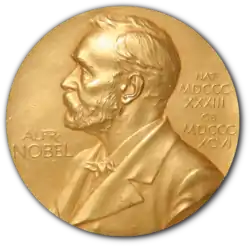Hans Fischer
Hans Fischer (27 July 1881 – 31 March 1945) was a German organic chemist and the recipient of the 1930 Nobel Prize for Chemistry "for his researches into the constitution of haemin and chlorophyll and especially for his synthesis of haemin."[1]
Hans Fischer | |
|---|---|
.jpg.webp) | |
| Born | 27 July 1881 |
| Died | 31 March 1945 (aged 63) |
| Cause of death | Suicide |
| Nationality | Germany |
| Alma mater | University of Lausanne, University of Marburg |
| Awards | Nobel Prize for Chemistry (1930) Davy Medal (1937) |
| Scientific career | |
| Fields | Chemistry |
| Institutions | University of Innsbruck, University of Vienna, Technical University of Munich |
| Doctoral advisor | Theodor Zincke |
| Other academic advisors | Emil Fischer |
| Doctoral students | |
Biography
Early years
Fischer was born in Höchst on Main, now a city district of Frankfurt. His parents were Dr. Eugen Fischer, Director of the firm of Kalle & Co, Wiesbaden, and Privatdozent at the Technical High School, Stuttgart, and Anna Herdegen. He went to a primary school in Stuttgart, and later to the "Humanistisches Gymnasium" in Wiesbaden, matriculating in 1899. He read chemistry and medicine, first at the University of Lausanne and then at Marburg. He graduated in 1904, and in 1908 he qualified for his M.D..[2]
Career
He worked first at a Medical Clinic in Munich and then at the First Berlin Chemical Institute under Emil Fischer. He returned to Munich in 1911 and qualified as lecturer on internal medicine one year later. In 1913 he became a lecturer in physiology at the Physiological Institute in Munich. In 1916 he became Professor of Medical Chemistry at the University of Innsbruck and from there he went to the University of Vienna in 1918.
From 1921 until his death he held the position of Professor of Organic Chemistry at the Technical University of Munich.
Fischer's scientific work was mostly concerned with the investigation of the pigments in blood, bile, and also chlorophyll in leaves, as well as with the chemistry of pyrrole from which these pigments are derived. Of special importance was his synthesis of bilirubin and haemin. He received many honours for this work, and received the Nobel Prize in 1930. The lunar crater Fischer was named after him (and Hermann Emil Fischer) in 1976.
Personal life
Fischer married Wiltrud Haufe in 1935. He committed suicide in Munich in despair over the destruction of his institute and his work during the last days of World War II.
Honours
- Fellow of the Academy of Sciences Leopoldina (1919)
- Privy Councillor (1925)
- Liebig Memorial Medal (1929)
- Nobel Prize for Chemistry (1930)
- Honorary doctorate, Harvard University (1936)
- Davy Medal of the Royal Society of London (1937)
Literature
- Heinrich Wieland (1950), "Hans Fischer und Otto Hönigschmid zum Gedächtniss", Angewandte Chemie, 62 (1): 1–4, doi:10.1002/ange.19500620102.
- Bickel, M H (2001), "[Henry E. Sigerist and Hans Fischer as pioneers of a medical history institute in Zurich]", Gesnerus, 58 (3–4), pp. 215–9, PMID 11810971
- Stern, A J (1973), "Hans Fischer (1881–1945)", Ann. N. Y. Acad. Sci., 206 (1), pp. 752–61, Bibcode:1973NYASA.206..752S, doi:10.1111/j.1749-6632.1973.tb43252.x, PMID 4584221, S2CID 40633114
- Watson, C J (1965), "Reminiscences of Hans Fischer and his laboratory", Perspect. Biol. Med., 8 (4), pp. 419–35, doi:10.1353/pbm.1965.0052, PMID 5323649, S2CID 32016198
- Kämmerer, H (1961), "Hans Fischer (1881–1945). A reminiscence on the 80th anniversary of his birth", Münchener Medizinische Wochenschrift (1950) (published Nov 3, 1961), 103, pp. 2164–6, PMID 14036988
References
- "The Nobel Prize in Chemistry 1930". nobelprize.org.
- Hans Fischer on Nobelprize.org
 including the Nobel Lecture, December 11, 1930 On Haemin and the Relationships between Haemin and Chlorophyll
including the Nobel Lecture, December 11, 1930 On Haemin and the Relationships between Haemin and Chlorophyll
External links
- Newspaper clippings about Hans Fischer in the 20th Century Press Archives of the ZBW

- Hans Fischer on Nobelprize.org
 including the Nobel Lecture, December 11, 1930 On Haemin and the Relationships between Haemin and Chlorophyll
including the Nobel Lecture, December 11, 1930 On Haemin and the Relationships between Haemin and Chlorophyll
